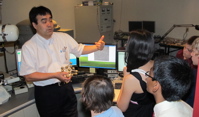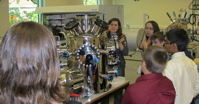Whiz Kids Explore New Nanocenter
Academic achievers representing more than 30 school districts gathered on the UALR campus last week to be recognized for their scholarship and to get a look at what college has in store.
 The students are participants in the Duke Talent Identification Program (TIP) based on test schools and classroom potential.
The students are participants in the Duke Talent Identification Program (TIP) based on test schools and classroom potential.
UALR’s Jodie Mahoney Center for Gifted and Talented Education sponsored the event, where 348 students were recognized for their achievement.
Based at Duke University, Duke TIP is a nonprofit organization dedicated to serving academically gifted and talented youth, working with students, their families, and educators to identify, recognize, challenge, engage, and help students reach their highest potential.
Qualifying fourth and fifth grade students may participate in Duke TIP’s fourth- and fifth-grade talent search and may take advantage of its optional above-level testing. The seventh grade talent search, which focuses on the identification, recognition, and support of high-ability students, offers qualifying seventh grade students the opportunity to take college entrance exams alongside high school students.
“In addition to the ceremony, students had an opportunity to learn about possible careers and fields of study,” said Dr. Ann Robinson, director of the Mahoney Center. “Students had an opportunity to visit UALR’s new nanotechnology center and the Virtual Reality Center as well as exploring topics such as songwriting, statistics, and the history of the Trail of Tears.”
At the new UALR Center for Integrative Nanotechnology Sciences, about 40 students visited with researchers discovering how elements behave at the atomic level and how those discoveries can be harnessed to create new products, companies, and jobs.
 Nanotechnology researchers helped the students put the size of a carbon nanotube in perspective by organizing tiny objects from the largest – a coffee bean – to the smallest – an x-ray wavelength.
Nanotechnology researchers helped the students put the size of a carbon nanotube in perspective by organizing tiny objects from the largest – a coffee bean – to the smallest – an x-ray wavelength.
“Dr. Fumiya Watanabe demonstrated the scanning electron microscope and transmission electron microscope allowing students to see the nanoparticles they had discussed to put it all in perspective,” said Traci Logsdon, communications and outreach coordinator of the nanotechnology center.
Students toured the new CINS facility with Dr. Enkeleda Dervishi and Dr. Shawn Bourdo, who explained the processes behind “growing” carbon nanotubes, generating anti-icing coatings, creating solar cells, and more.